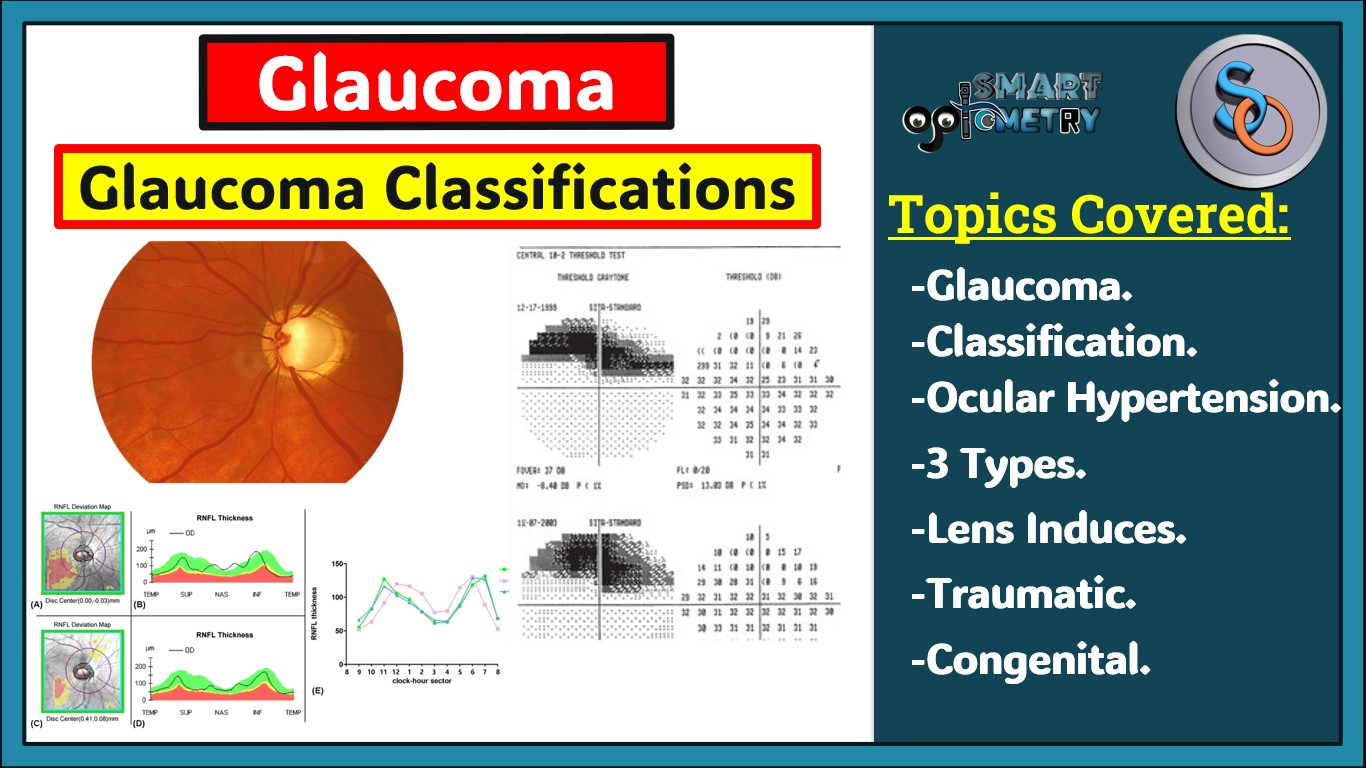What is Glaucoma?
- We will call it glaucoma when there are:
- 1. Characteristic appearance of the optic disc:
- High Cup-Disc Ratio: Normal Disc-Cup is upto 1:0.3, Disc-Cup ratio more than 1 : 0.3 is considered Glaucoma suspect
- 2. Characteristic visual field defects:
- In Glaucoma, peripheral visual field is affected first and result in tubular vision
- 3. With or Without Raised Intra-Ocular Pressure:
- Raised IOP (more than 22 mm of Hg) is frequently associated but not always.
- 1. Characteristic appearance of the optic disc:
What is Normal Tension Glaucoma or Low-Tension Glaucoma?
When IOP is normal, but high cup-disc ratio and visual defects are there then it’s called Normal Tension Glaucoma (NTG) or Low-Tension Glaucoma (LTG).
What is Ocular Hypertension?
When IOP is high, but cup-disc ratio is normal, and no visual defects are there then it’s called Ocular Hypertension.
- Most types of glaucoma has no prominent symptoms due to which patients are not aware of glaucoma and come to physician when significant vision & visual field loss already developed.
- Thus, It is called Silence thief of vision or Silent Killer.
.
.
Classification of Glaucoma:
- 1. Clinico-etiological Classification:
- (A) Congenital & developmental glaucoma:
- 1. Primary congenital glaucoma.
- 2. Developmental glaucoma.
- (B) Primary adult glaucoma
- 1. Primary open angle glaucoma (POAG).
- 2. Primary angle closure glaucoma (PACG).
- 3. Primary mixed mechanism glaucoma.
- (C) Secondary glaucoma:
- (A) Congenital & developmental glaucoma:
- 2. Depending upon the mechanism of rise in IOP
- a. Secondary open angle glaucoma.
- b. Secondary angle closure glaucoma.
- 3. Depending upon the causative primary disease:
- 1. Lens-induced glaucoma.
- 2. Inflammatory glaucoma
- 3. Pigmentary glaucoma.
- 4. Neovascular glaucoma.
- 5. Pseudoexfoliative glaucoma.
- 6. Glaucoma due to hemorrhage.
- 7. Steroid-induced glaucoma.
- 8. Traumatic glaucoma.
- 9. Glaucoma-in-aphakia.
- 10. Glaucoma associated with tumour.
.
.
1. Clinico-Etiological Classification:
(A) Congenital & developmental glaucoma:
- 1. Primary congenital glaucoma:
- It occurs due to Anomalies of eyeball.
- 2. Developmental glaucoma:
- It is not associated with any Anomalies.
(B) Primary adult glaucoma:
1. Primary open angle glaucoma (POAG):
- It occurs in eyes with open angle of the anterior chamber and there is no obvious systemic or ocular cause of rise in the intraocular pressure.
2. Primary angle closure glaucoma (PACG):
- Rise in intraocular pressure occurs due to blockage of the aqueous humor outflow by closure or narrower the angle of the anterior chamber.
3. Primary mixed mechanism glaucoma:
- It refers to elevated IOP in which both open-angle and angle closure glaucoma mechanisms are present.
(C) Secondary glaucoma:
- It refers to rise of intraocular pressure associated with some primary ocular or systemic diseases.
.
.
2. Depending upon the mechanism of rise in IOP:
a. Secondary open angle glaucoma:
- In which aqueous outflow may be blocked by a pre-trabecular membrane, trabecular clogging, oedema and scarring or elevated episcleral venous pressure.
b. Secondary angle closure glaucoma:
- In which raised IOP may or may not be associated with pupillary block.
3. Depending upon the causative primary disease:
1. Lens-induced glaucoma:
- In this group, IOP is raised secondary to some disorder of the crystalline lens. Common subtypes are:
a. Phacomorphic glaucoma:
- It is an acute secondary angle-closure glaucoma caused by swollen cataractous lens due to rapid maturation of cataract or traumatic rupture of capsule.
b. Phacolytic glaucoma (Lens protein glaucoma):
- IOP Raised due to trabecular meshwork is clogged by the leakage lens proteins come out through an intact capsule in the hypermature (Morgagnian) cataractous lens.
2. Inflammatory glaucoma:
- Mostly occurred due to inflammations of the uveal tissue (iridocyclitis) by Uveitis.
- Even in other ocular inflammations such as keratitis and scleritis, the rise in IOP is usually due to secondary involvement of the anterior uveal tract.
a. Hypertensive uveitis:
- Hypertensive uveitis refers to acute inflammation of the anterior uvea associated with raised IOP.
b. Post-inflammatory glaucoma:
- In it, IOP is raised due to after-effects of the iridocyclitis due to pupillary block in synechiae, angle closure glaucoma due to iris root swelling & open angle glaucoma due to debris obstruction in trabecular meshwork.
.
.
3. Pigmentary Glaucoma:
- IOP Raised due to clogging up of the trabecular meshwork occurs by the pigment particles.
4. Neovascular Glaucoma (NVG):
- IOP raised due to formation of neovascular membrane involving the angle of anterior chamber.
5. Pseudoexfoliative Glaucoma (Glaucoma Capsulare):
- Pseudoexfoliation syndrome (PES) is characterised by deposition of an amorphous grey dandruff-like material on the pupillary border, anterior lens surface, posterior surface of iris, zonules and ciliary processes.
6. Glaucoma in Pseudophakia:
- IOP raised due to hyphema after cataract surgery, post-operative steroid medication etc.
7. Steroid-induced Glaucoma:
- It is a type of secondary open-angle glaucoma which develops following topical, and sometimes systemic steroid therapy.
.
.
8. Traumatic Glaucoma:
- It is associated with trauma and IOP raised due to inflammation, Hemorrhage, swollen or dislocated lens, traumatic synechiae etc.
9. Glaucoma in Intraocular Haemorrhages:
- IOP raised due to intraocular haemorrhages including hyphema and vitreous haemorrhage due to blockage of trabecular meshwork by RBCs, obstruction (clogging) of the trabecular meshwork etc.
10. Glaucoma in Intraocular Tumor:
- Occurs in intraocular tumors such as malignant melanoma of iris, choroid, ciliary body and retinoblastoma
- IOP raised due to trabecular block due to clogging by tumour cells, Neovascularization of the angle, and forward displacement of iris-lens diaphragm by increasing tumour mass.
- Check Our Courses: Ophthalmic Instrumentation, Clinical Refraction, Contact Lens, Binocular Vision, Dispensing Optics, MCQs in Optometry
- Download our App “Optometry Notes & MCQs” from Google Play Store.




